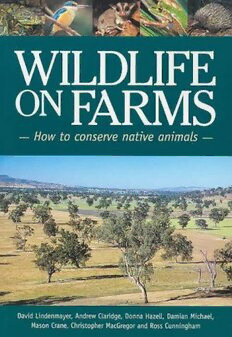
Wildlife on Farms: How to Conserve Native Animals PDF
129 Pages·2003·39.341 MB·English
Most books are stored in the elastic cloud where traffic is expensive. For this reason, we have a limit on daily download.
Preview Wildlife on Farms: How to Conserve Native Animals
Description:
Many landowners are interested in the native animals that live on their farms or once occurred there. In particular they want to know why particular species are present (or absent), what they can do to encourage them to visit, and what they might do to keep them there. Wildlife on Farms outlines the key features of animal habitats—large flowering trees, hollow trees, ground cover, understorey vegetation, dams and watercourses—and describes why landholders should conserve these habitats to encourage wildlife on their farms. It shows how wildlife conservation can be integrated with farm management and the benefits this can bring. The book presents 29 example species—mammals, birds, reptiles and amphibians—that are common to a large part of southern and eastern Australia. Each entry gives the distinguishing features of the animal, key features of its required habitat, and what can be done on a farm to better conserve the species. Wildlife on Farms has been written after a seven-year study of biodiversity conservation in agricultural/grazing landscapes in south-eastern Australia. The authors David Lindenmayer, Donna Hazell, Damian Michael, Mason Crane and Christopher MaGregor are ecologists working at the Centre for Resource and Environmental Studies, The Australian National University in Canberra. Andrew Claridge formerly worked at the Centre for Resource and Environmental Studies and is now a threatened species biologist with the New South Wales National Parks and Wildlife Service.
See more
The list of books you might like
Most books are stored in the elastic cloud where traffic is expensive. For this reason, we have a limit on daily download.
